Celta Vigo currently sit in 16th position in La Liga after a poor start to the season. This club has flirted with relegation in previous seasons, and this season it also seems like a real possibility. Carlos Carvalhal has come into the club just before the FIFA World Cup to try to help them retain their spot in the top tier of Spanish football, but their leaky defence will need a lot of work if fortunes are to change.
From set pieces, Celta Vigo have conceded 8 goals in the season up until now, and with that being nearly 30% of all goals they’ve conceded, it looks to be one of the key reasons for their poor season.
In this tactical analysis, we will delve into the tactics used by Celta Vigo when they are defending set pieces, with an analysis of why things have gone so wrong for them. This set-piece analysis will look at the different defensive methods they’ve used when defending both free kicks and corners and where they will need to improve to stop being so leaky from such scenarios in the future.
Man Marking Approach
At the start of the season, Celta Vigo opted for a man-marking defensive system, giving each defensive player responsibility for an attacker, trusting in them to win the individual 1v1 battles. Below we can see their set-up, with six-man markers (yellow) and two zonal markers (blue). One player stayed on the edge of the box to pick up any clearances while one player stayed high for an opportunity to counterattack.

While this system can work, when each defender prevents the attacker from creating separation and reaching the ball, it is extremely difficult to perfect, and so mistakes often appear. This is the case, especially amongst players with poorer concentration, who lose track of either their player or the ball, leaving them lost and almost in no man’s land.
The defender’s job is extremely difficult. A defender must track the runner, to disrupt their run and prevent them from reaching the ball. However, a defender also has to track the flight of the ball in order to help them predict the run of the attacker and to attack the ball should it come towards them. If a defender only focuses on the ball, they could easily lose their marker who could break free into a dangerous position. If a defender only focuses on the attacker, they risk giving away a penalty and will be unable to clear the ball even if it comes directly towards them. It is a difficult role to play and not one that just any player can fill in.
This example below shows Aidoo only looking at his attacker. He perfectly illustrates that not looking at the ball causes man-marking to be ineffective. As the ball is crossed towards the front of the six-yard box, Aidoo should position himself in the attacker’s path, to disrupt and block the run. However, Aidoo stays side by side, meaning the attacker will have a clear run towards the ball once it is crossed in. Furthermore, not looking at the ball means Aidoo does not know when the ball will be delivered, so the attacker will be able to make the first step when attacking the ball, giving him the small head start needed to arrive at the ball first.
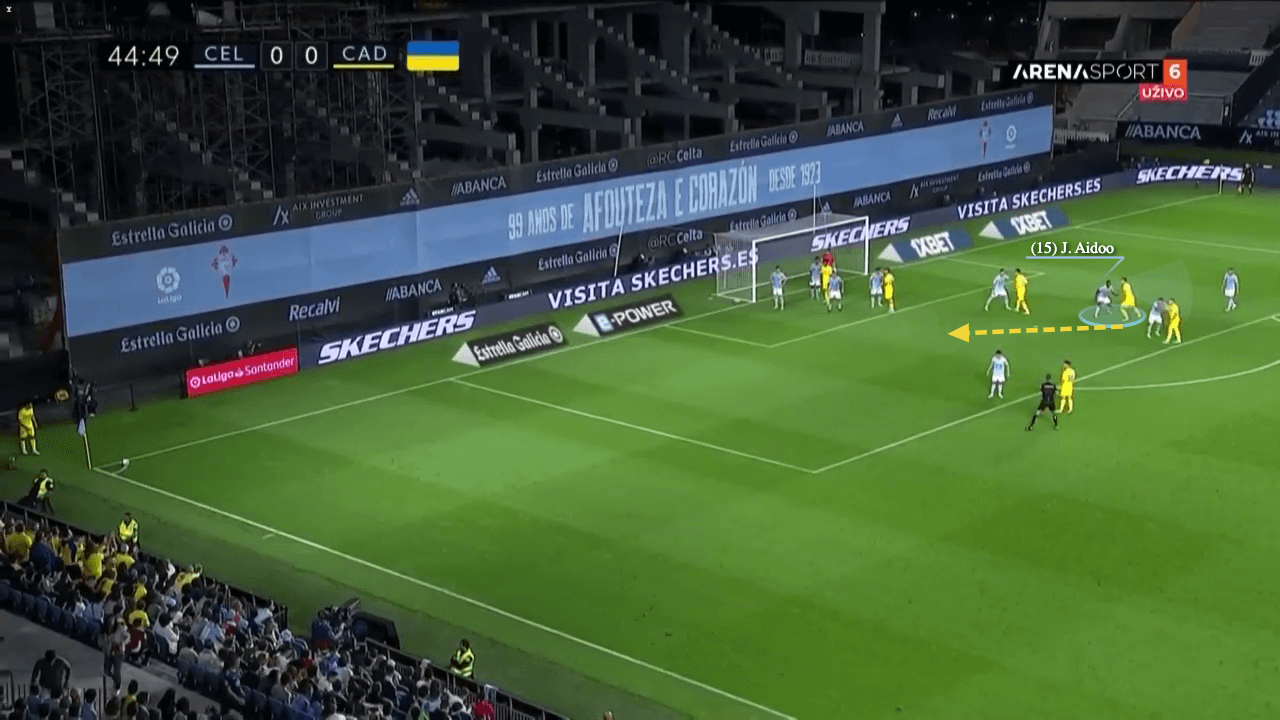
Shift To Zonal Orientation
Once Carlos Carvalhal came to the club just before the World Cup, he changed Celta Vigo’s defensive approach, moving to a zonal defending system. Pictured below, we can see six zonal markers (blue) and just two man markers (red) while they leave a player on the edge to collect loose balls (yellow), with one player high up the pitch.
Something interesting that stands out is the close proximity of the three zonal markers at the back post, where it is clear they had prepared for Osasuna‘s tactic of delivering balls towards the back of the six-yard box.
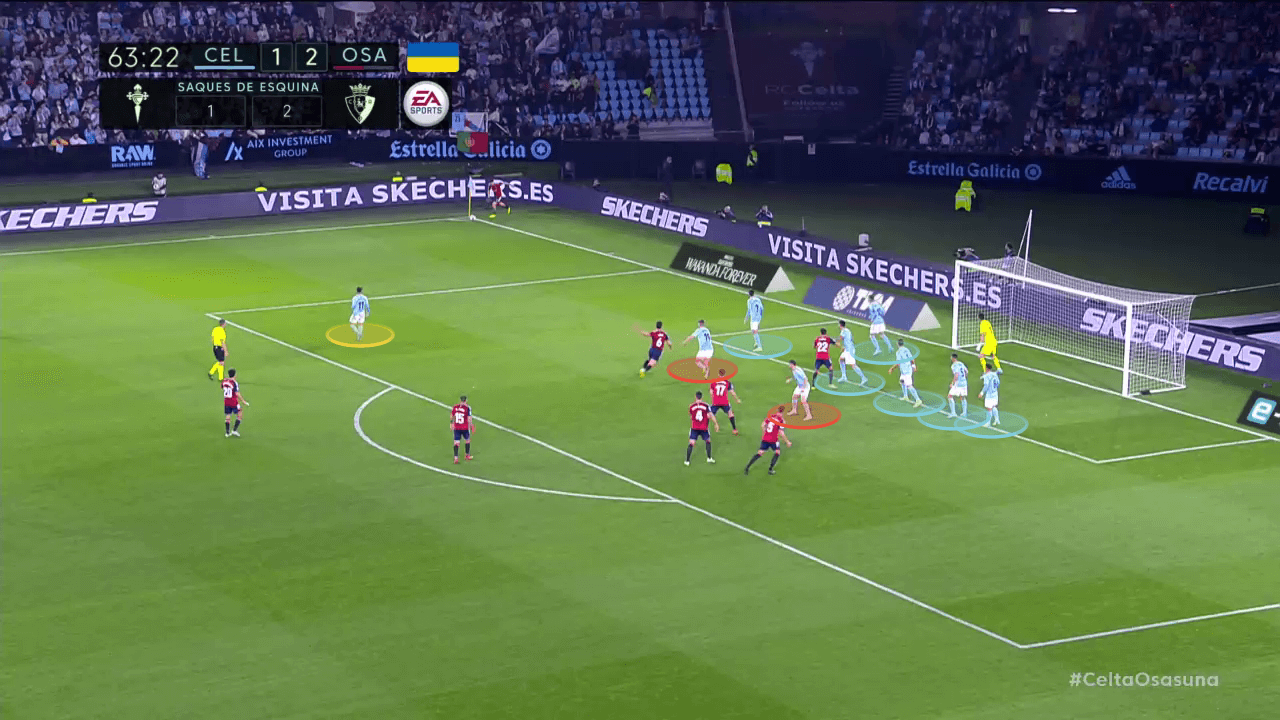
Zonal marking allows teams to heavily overload areas closer to the goal, meaning that wherever the ball may be crossed into, a defender should always already be close enough to challenge for the ball. Teams are then forced to deliver the ball slightly further from the goal, where a header is harder to score due to the added reaction time for the keeper made available.
One weakness of a zonal defensive approach is its inability to track the attackers. Man markers are meant to disrupt runners, preventing them from running and attacking the ball. The full zonal system allows attackers to run towards the ball, and challenge for the ball. Deep runs like the one pictured below cause zonal systems the most problems, where a player has around six yards of space in front of him where he can gain momentum to leap towards the ball whilst the defending team is static.
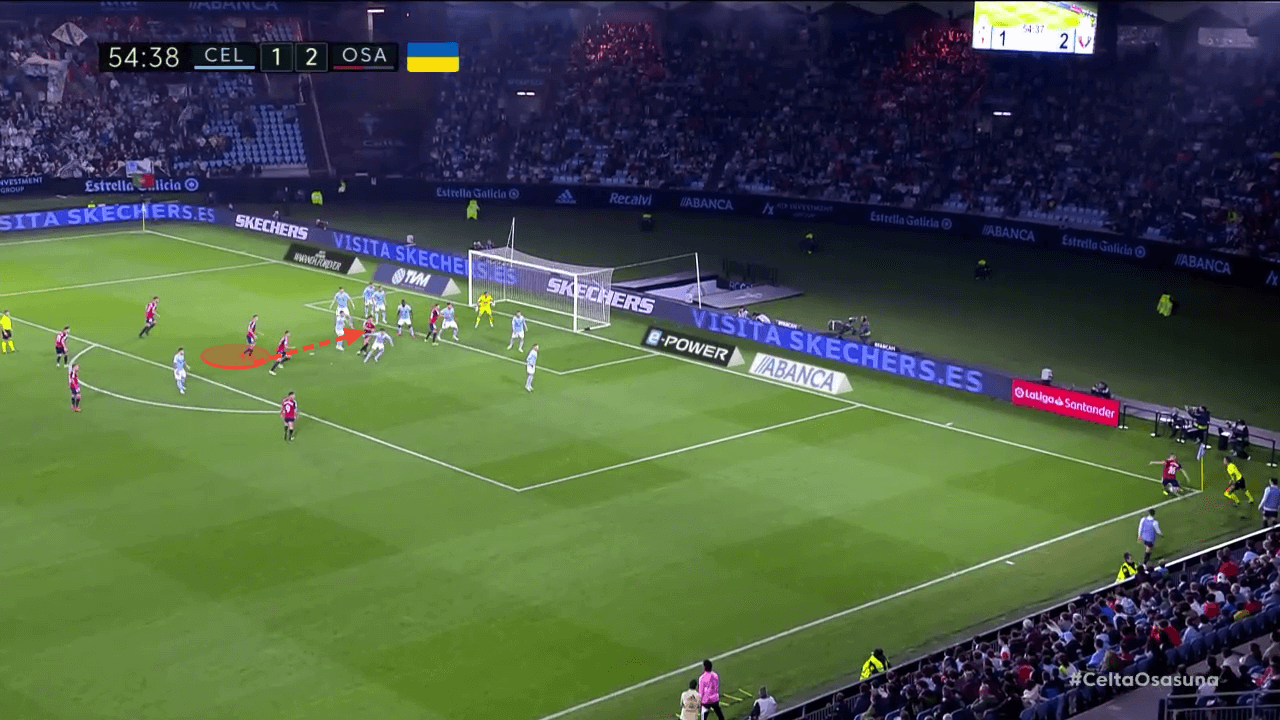
Looking at the picture below, if you can track the runner highlighted above, we can see the player with his knees bent and about to explode up in the air, after a six-yard run-up. Just behind him, we can see a defender mid-stride. The defender is still having to move to get into the position from where he should jump, whilst the attacker is already there because of the early run-up that he was allowed to make.
Furthermore, being mid-stride means that the defender can’t get up in the air even slightly, meaning that the attacker will have a large distance between himself and the attacker, making the header easier to direct towards the goal.
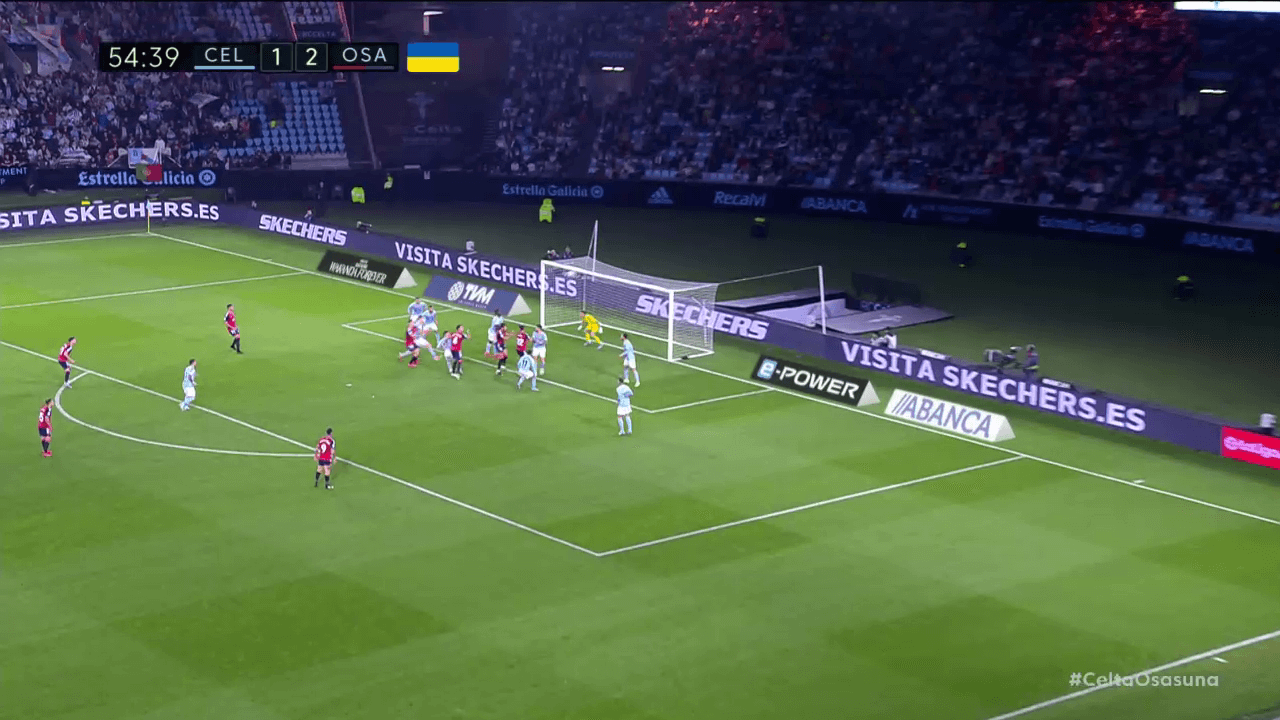
The above analysis has shown that an unmarked run allows the attacker to 1) arrive in the correct zone earlier and 2) gain momentum to jump higher. Being in the correct place early means you can jump earlier over the defender, preventing him from being able to jump at all, while the added momentum allows you to gain an even bigger advantage in the air to make the headed effort as simple as possible. In the image below we can see this come to life, with the attacker’s feet at the same height as the defender’s upper leg, making that advantage very evident.
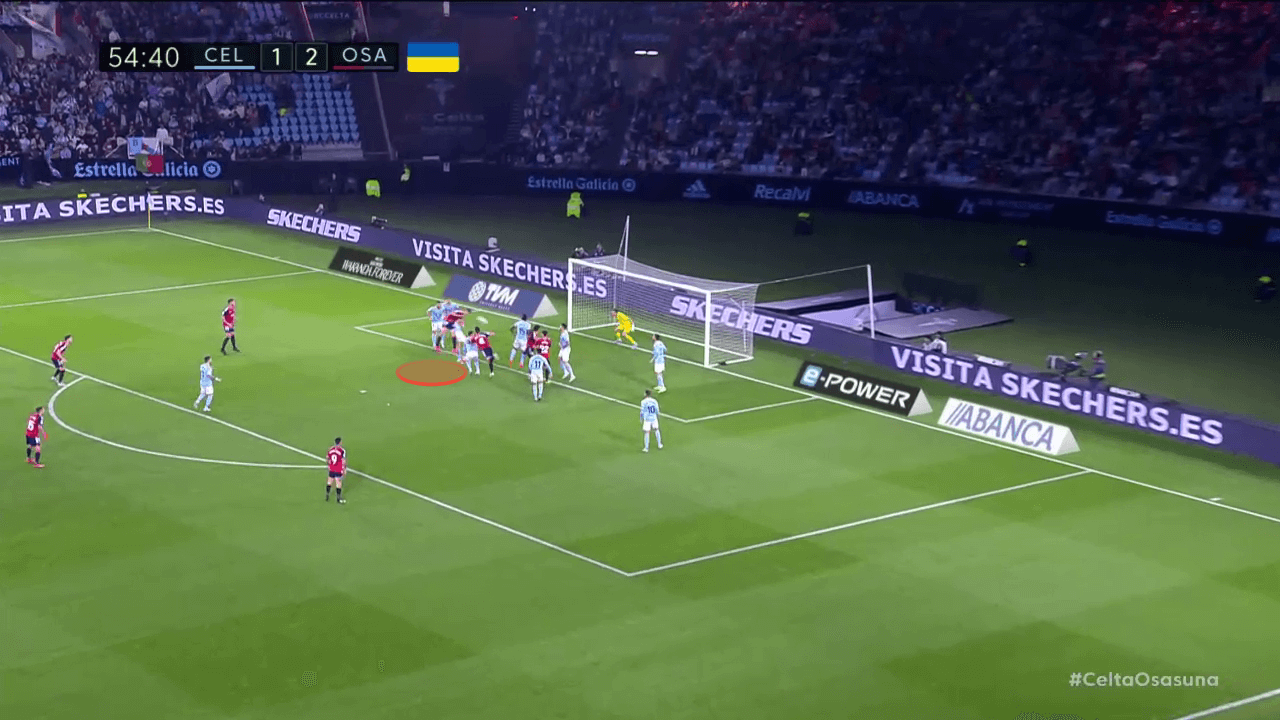
Another issue with zonal marking is the lack of responsibility players can have. Sometimes it can be hard to tell whether the ball is going into your zone or the one behind/in front of you, and so players can quickly shift the blame to other teammates. Players can become rooted to their spot, making it easy for attackers to find spaces from where they can get a headed effort off on goal.
The image below displays how every player left the ball, assuming that it should be cleared by their teammate. As a result, no one goes to clear the ball, and so there is a free header from six yards out.
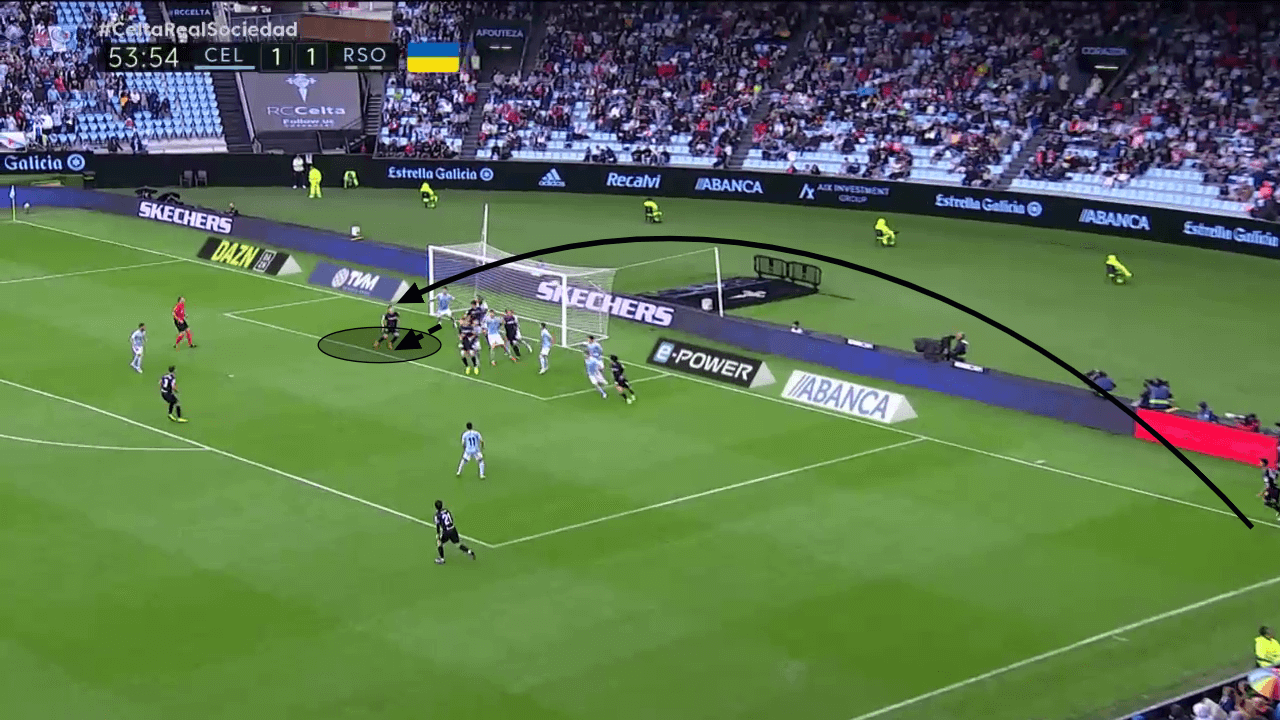
Problems From Free Kicks
During free kicks in wide areas, individual problems during man-marking setups have continued to be very costly for Celta Vigo. From free kicks, it is easier to keep an eye on both the ball and the attacker, as the defenders don’t have to turn their heads consistently. However, the Celta Vigo defenders lack the communication and marking skills to effectively man mark even in simpler situations.
As the Real Sociedad players move in and around the box, the Celta Vigo defenders begin to lose track of their markers as they have to turn their heads. The image below shows that two players are looking at one man, whilst one defender sneaks off behind their backs.
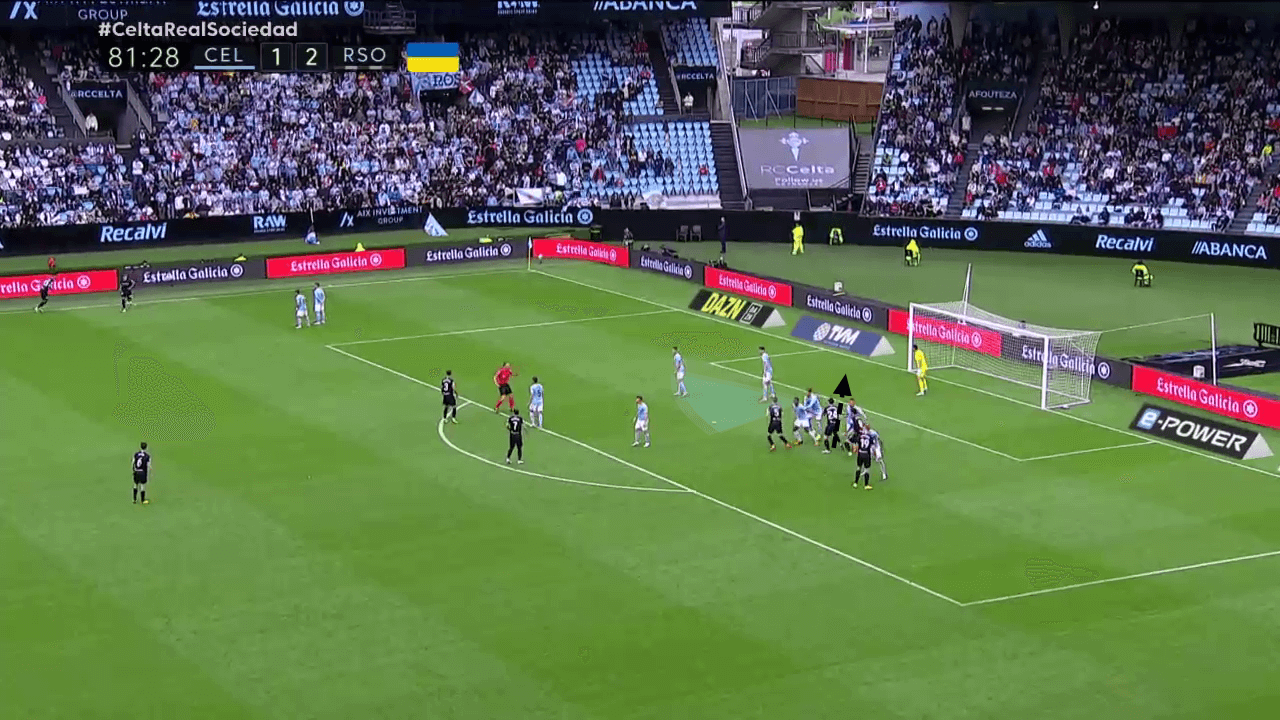
The rotation of the attackers has caused the defensive unit to lose track of their markers. Although most of the players have been able to stick with their men, Paciencia has lost track of his man. Paciencia was instructed to mark a specific player, but once that player was picked up by someone else, he failed to assume the responsibility to pick up someone else who is spare.
Furthermore, we can see a different Sociedad attacker dismark himself through a quick change of direction, due to the defender being too tight and unable to react quickly enough to the change in movement. As a result, Celta Vigo leave two players free in the middle of the six-yard box due to a mixture of mistakes.
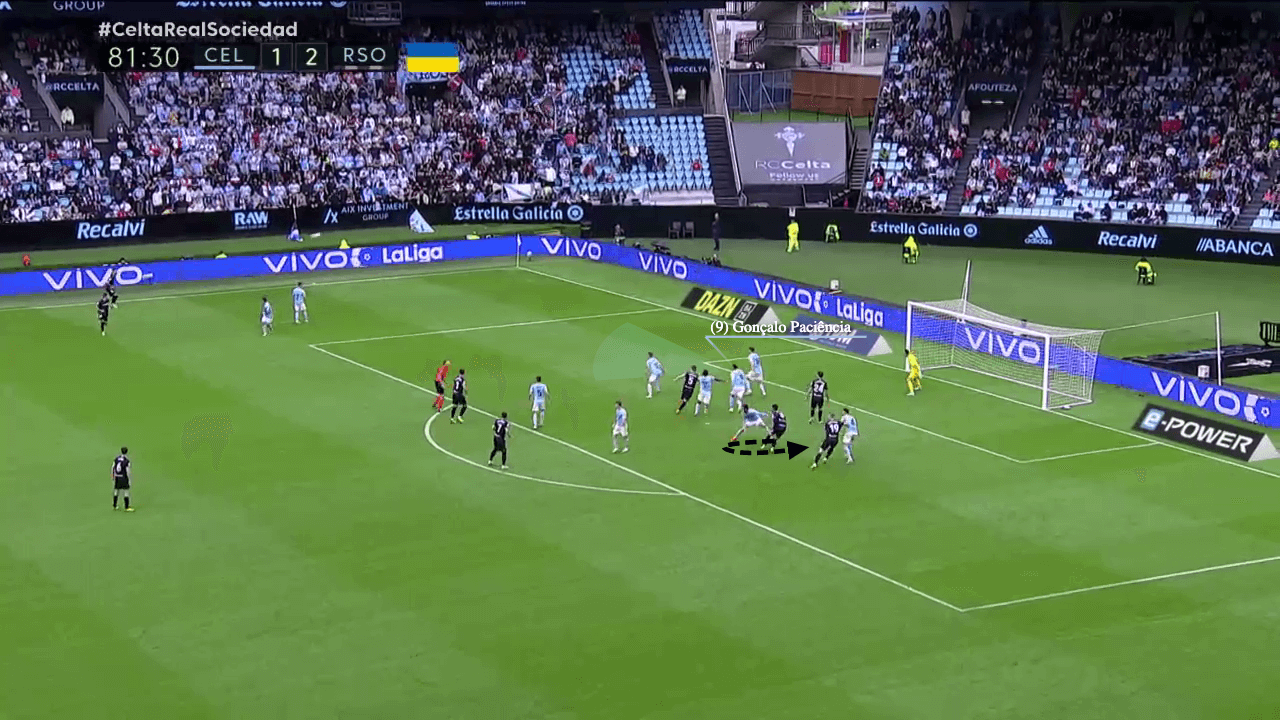
Carlos Carvalhal coming in meant that Celta Vigo oriented to a mixture of man-marking and zonal marking from free kicks. We can see in the picture below a line of zonal markers (black) and a line of man markers (white). The man markers are tasked with disrupting the attackers, whilst the zonal markers clear anything that comes towards the six-yard box.
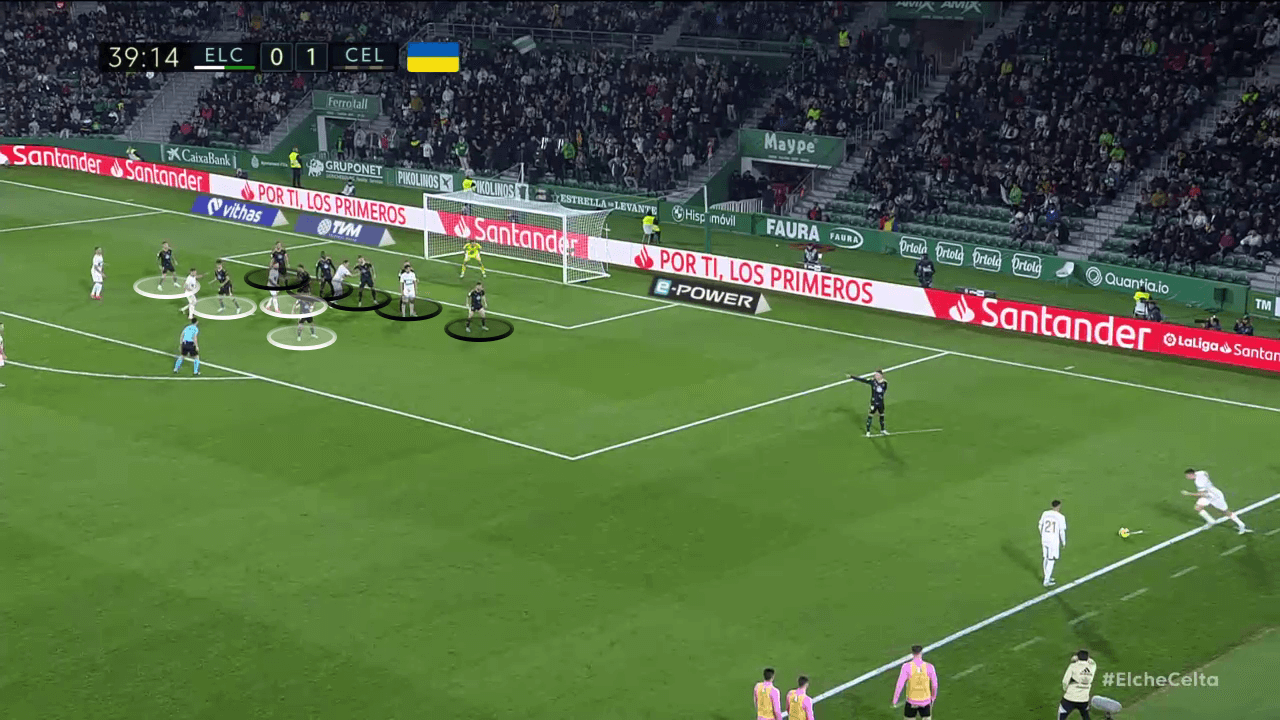
The issue that arises for Celta Vigo in these instances is when opposing players float around the zonal markers, meaning that they aren’t picked up. In the image above, we can see a white shirt standing by a zonal marker who cannot leave his zone. As a result, that white player can attack the ball unmarked.
Once the free kick is taken, the zonal markers naturally step back towards their own goal, whilst the attackers who are being man-marked attack the back post. As a result, this white area opens up just outside the six-yard box which can be attacked by any player who was using the zonal markers to create a false image of being marked. Celta Vigo’s defenders have to be more aware of the threats around the box in order to limit the number of players who can stay unmarked.
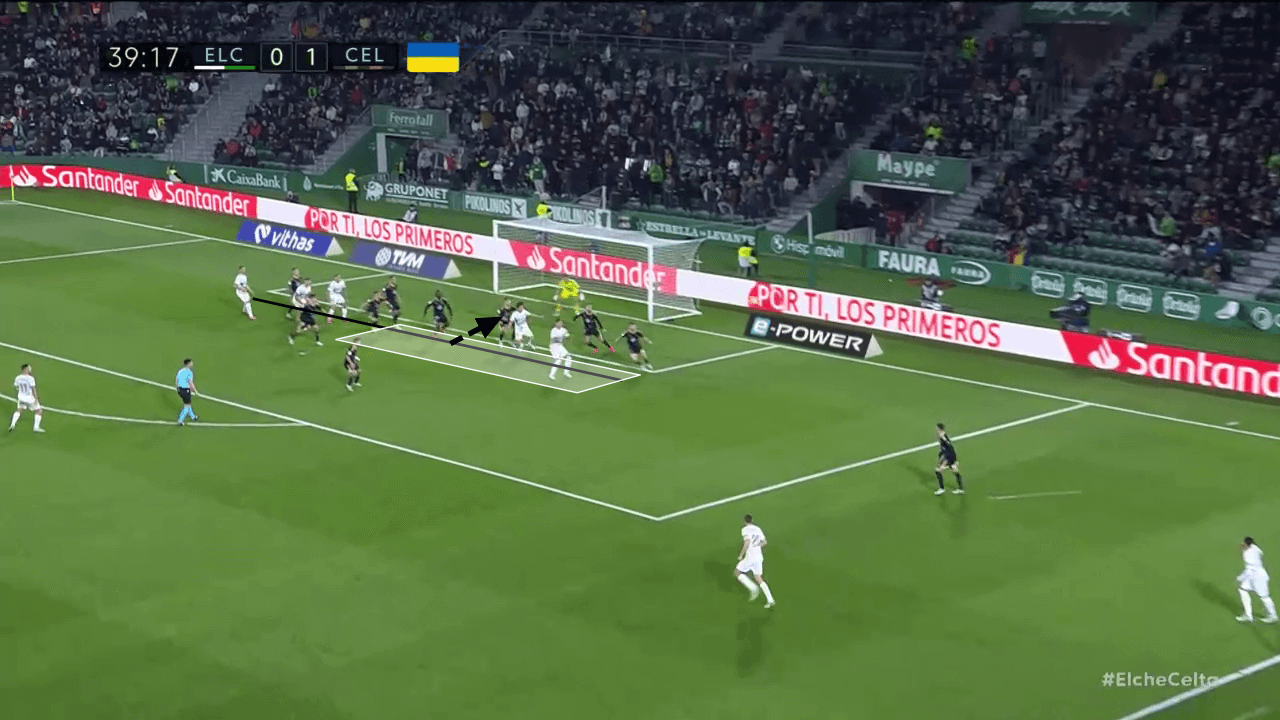
Summary
Celta Vigo have attempted both extremes when defending set pieces, using both zonal and man-marking systems. However, each style has its flaws, so a system which uses elements of both could help limit the number of chances they concede from such situations. Furthermore, individual mistakes from players when defending crosses have meant that Celta Vigo have been one of the leakiest teams from set-plays, and this is something that needs to be educated out of each player if they want to retain their place in La Liga.



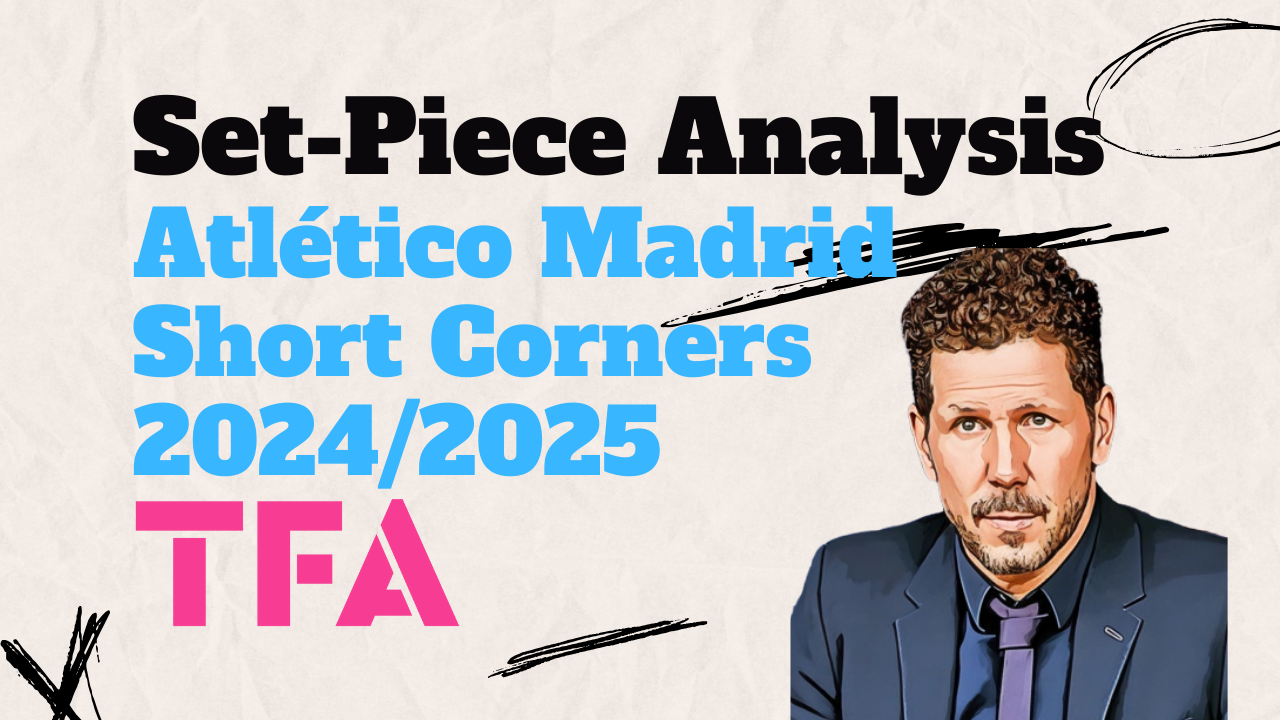
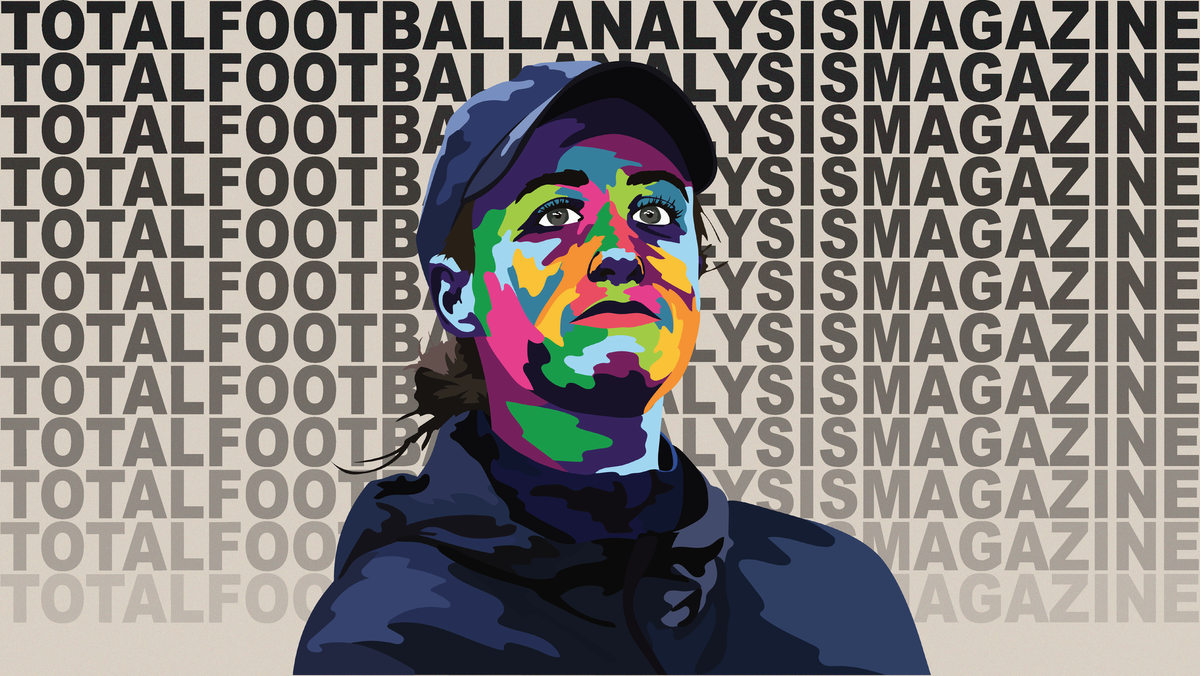
Comments